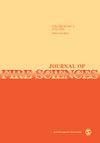定向刨花板热解模型的建立。第一部分:热分解的动力学和热力学
IF 1.9
4区 工程技术
Q2 ENGINEERING, MULTIDISCIPLINARY
引用次数: 10
摘要
定向刨花板是一种广泛使用的建筑材料,承担了许多建筑物的很大一部分火灾负荷。为了准确地模拟定向刨花板对火灾的响应,采用热重分析、差示扫描量热法和微尺度燃烧量热法测试,利用数值求解器ThermaKin和爬坡优化算法构建了定向刨花板的热分解模型。该模型包括一个单步水蒸发反应和四个连续反应,代表定向刨花板有机成分的热分解。实验和模拟结果表明,前两个反应为吸热反应,后两个反应为放热反应。发现净分解热接近于零。测定了凝析相物质的热容和放出气体的燃烧热。燃烧热在分解过程中发生变化,这是模型捕捉到的趋势。该材料的完整热解模型的开发将是本工作第二部分的主题。本文章由计算机程序翻译,如有差异,请以英文原文为准。
Development of a pyrolysis model for oriented strand board. Part I: Kinetics and thermodynamics of the thermal decomposition
Oriented strand board is a widely used construction material responsible for a substantial portion of the fire load of many buildings. To accurately model the response of oriented strand board to fire, thermogravimetric analysis, differential scanning calorimetry, and microscale combustion calorimetry tests were carried out to construct a thermal decomposition model using a numerical solver, ThermaKin, and a hill climbing optimization algorithm. The model included a single-step water vaporization reaction and four consecutive reactions representing thermal decomposition of organic constituents of oriented strand board. The experiments and modeling revealed that the first two of the four reactions are endothermic, while the last two are exothermic. The net heat of decomposition was found to be near zero. The heat capacities of condensed-phase species and heats of combustion of evolved gases were also determined. The heats of combustion were found to vary over the course of decomposition—the trend captured by the model. Development of a complete pyrolysis model for this material will be a subject of Part II of this work.
求助全文
通过发布文献求助,成功后即可免费获取论文全文。
去求助
来源期刊

Journal of Fire Sciences
工程技术-材料科学:综合
CiteScore
4.00
自引率
0.00%
发文量
14
审稿时长
2.5 months
期刊介绍:
The Journal of Fire Sciences is a leading journal for the reporting of significant fundamental and applied research that brings understanding of fire chemistry and fire physics to fire safety. Its content is aimed toward the prevention and mitigation of the adverse effects of fires involving combustible materials, as well as development of new tools to better address fire safety needs. The Journal of Fire Sciences covers experimental or theoretical studies of fire initiation and growth, flame retardant chemistry, fire physics relative to material behavior, fire containment, fire threat to people and the environment and fire safety engineering. This journal is a member of the Committee on Publication Ethics (COPE).
 求助内容:
求助内容: 应助结果提醒方式:
应助结果提醒方式:


